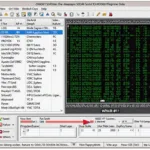CalAmp OBD2 devices are transforming fleet management and vehicle diagnostics. These powerful tools offer a wealth of data and insights, improving efficiency, safety, and operational costs. This guide will explore the functionalities, benefits, and applications of CalAmp OBD2 devices, helping you understand how they can benefit your business or personal vehicle.
What is a CalAmp OBD2 Device?
CalAmp OBD2 devices are telematics units that plug into a vehicle’s OBD-II port, providing real-time data on vehicle location, diagnostics, driver behavior, and more. They leverage GPS and cellular technology to transmit information to a central platform, allowing fleet managers and individual users to monitor vehicle activity remotely. These devices go beyond basic OBD2 scanners, offering advanced features like geofencing, engine diagnostics, and driver scoring.
Benefits of Using a CalAmp OBD2 Device
CalAmp OBD2 devices offer numerous advantages for both businesses and individuals:
- Improved Fleet Management: Track vehicle location, monitor driver behavior, and optimize routes for greater efficiency.
- Enhanced Vehicle Diagnostics: Receive real-time alerts on potential mechanical issues, enabling proactive maintenance and reducing downtime.
- Increased Safety and Security: Features like geofencing and impact detection enhance vehicle security and driver safety.
- Reduced Operational Costs: Optimize fuel consumption, minimize unnecessary idling, and improve maintenance scheduling to lower overall expenses.
- Simplified Data Analysis: Access comprehensive data reports and analytics to identify areas for improvement and make informed decisions.
Key Features of CalAmp OBD2 Devices
CalAmp OBD2 devices are packed with features designed to enhance vehicle management and diagnostics:
- Real-Time Location Tracking: Monitor vehicle location and movement with precise GPS tracking.
- Engine Diagnostics: Receive detailed engine data and diagnostic trouble codes (DTCs) to identify potential problems.
- Driver Behavior Monitoring: Track driver habits like speeding, harsh braking, and rapid acceleration to promote safer driving practices.
- Geofencing: Create virtual boundaries to receive alerts when vehicles enter or exit designated areas.
- Fuel Management: Monitor fuel consumption and identify areas for improvement to reduce fuel costs.
- Maintenance Scheduling: Set automated reminders for routine maintenance tasks based on mileage or engine hours.
How Does a CalAmp OBD2 Work?
A CalAmp OBD2 device plugs directly into the vehicle’s OBD-II port, accessing data from the vehicle’s onboard computer. This data is then transmitted wirelessly via cellular networks to a central platform where it can be accessed and analyzed. Users can access this information through web portals or mobile apps.
CalAmp OBD2 vs. Traditional OBD2 Scanners
While both provide diagnostic information, CalAmp OBD2 devices go beyond the capabilities of traditional OBD2 scanners:
- Real-time tracking and data logging: Unlike traditional scanners, CalAmp devices constantly monitor vehicle data and transmit it in real time.
- Remote access and reporting: Data can be accessed remotely, allowing for comprehensive reporting and analysis.
- Integration with fleet management platforms: CalAmp devices seamlessly integrate with fleet management software for comprehensive vehicle management.
What are the Common Uses of CalAmp OBD2?
CalAmp OBD2 devices are used across various industries and applications:
- Fleet Management: Optimizing routes, monitoring driver behavior, and improving vehicle maintenance.
- Insurance Telematics: Monitoring driving habits to assess risk and personalize insurance premiums.
- Vehicle Tracking and Recovery: Locating stolen vehicles and assisting in recovery efforts.
- Personal Vehicle Monitoring: Tracking vehicle location, monitoring teen driving, and receiving diagnostic alerts.
“CalAmp OBD2 devices provide unparalleled visibility into fleet operations, allowing businesses to make data-driven decisions that improve efficiency and profitability,” says John Smith, Fleet Manager at Acme Transportation.
Choosing the Right CalAmp OBD2 Device
Selecting the right CalAmp OBD2 device depends on your specific needs and requirements. Consider factors like:
- Features: Choose a device with the features you need, such as GPS tracking, engine diagnostics, and driver behavior monitoring.
- Connectivity: Ensure the device is compatible with your cellular network and data plan.
- Integration: Check if the device integrates with your existing fleet management software.
Conclusion
CalAmp OBD2 devices offer a powerful solution for vehicle management and diagnostics. Their comprehensive features and real-time data insights can benefit businesses and individuals alike, improving efficiency, safety, and operational costs. By investing in a CalAmp OBD2 device, you are investing in a smarter, more connected future for your vehicles.
FAQ
- How do I install a CalAmp OBD2 device? Simply plug the device into the vehicle’s OBD-II port.
- What type of data does a CalAmp OBD2 device collect? Data includes location, speed, engine diagnostics, driver behavior, and fuel consumption.
- Is a data plan required for a CalAmp OBD2 device? Yes, a cellular data plan is required for data transmission.
- Can I use a CalAmp OBD2 device with my personal vehicle? Yes, CalAmp offers devices for both personal and commercial use.
- How can I access the data collected by my CalAmp OBD2 device? Data can be accessed through web portals or mobile apps.
- Are CalAmp OBD2 devices compatible with all vehicles? Most vehicles manufactured after 1996 are compatible with OBD2 devices.
- What is the cost of a CalAmp OBD2 device? Pricing varies depending on the specific model and features.
For further assistance, please contact our 24/7 customer support team via WhatsApp: +1(641)206-8880, or Email: [email protected]. We are here to help!


